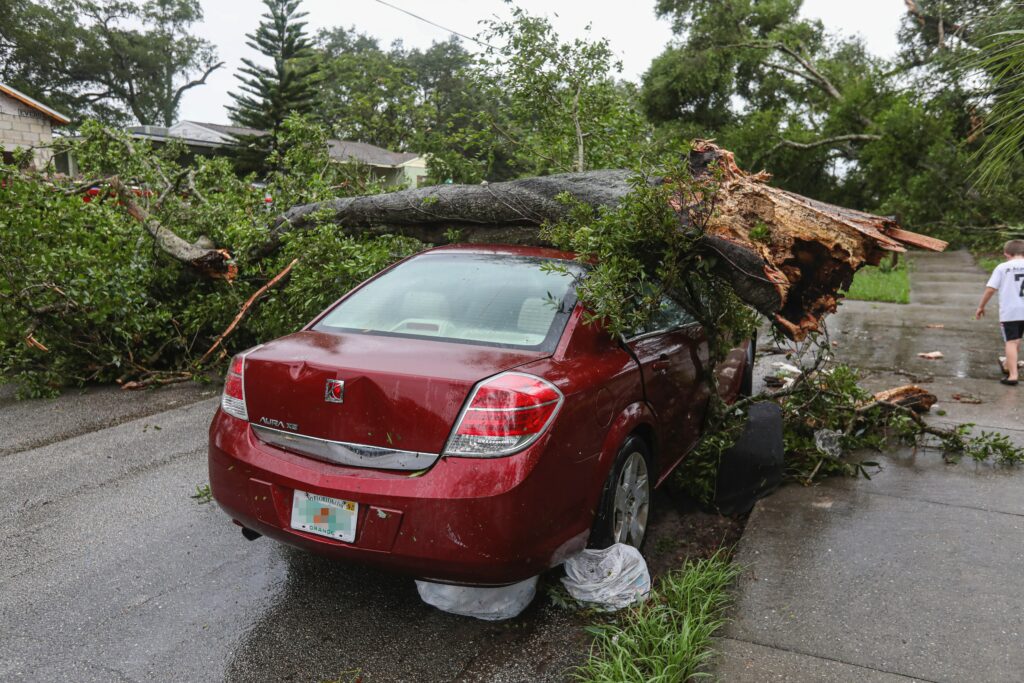Trees often create conflicts between neighbors over ownership, tree trimming, overhanging branches, damage caused by roots, and property damage caused by falling branches.
This article aims to shed light on conflicts involving trees and neighbors and answer common questions that arise.
If My Neighbor’s Tree Branches Cross The Property Line, Can I Trim Them Back?
Courts in each State have crafted different rules to resolve this issue. The courts have taken two main approaches to resolve these issues.
The two main approaches are:
- The Massachusetts Rule.
- The Hawaii Rule.
Massachusetts Rule
The “Massachusetts Rule” originates from a 1931 Massachusetts court case, Michalson v. Nutting, and it’s a legal precedent used to address disputes over tree branches (or roots) encroaching across property lines. It is the oldest Rule states use to resolve tree dispute issues.
Under the Massachusetts Rule, a property owner has the absolute right to cut off branches and roots of a neighboring tree that encroach onto their property.
However, the owner cannot cross the property line to trim or cut the tree.
This Rule is based on a principle of self-help, meaning that a property owner is responsible for managing any intrusion onto their property by a neighbor’s tree.
Under the Massachusetts Rule, a neighbor can trim the branches back to the property line at their own expense.
An important note about the Massachusetts Rule is that it doesn’t assign blame or liability for the natural growth of trees. Instead, it puts the onus on the affected property owner to address any inconvenience or damage caused by the encroachment.
The following States have adopted and follow the Massachusetts Rule:
Hawaii Rule
The Hawaii Rule is the modern approach courts have followed concerning encroaching tree branches.
Under the Hawaii Rule, if tree branches cause damage or pose an immediate danger to the adjoining property, the neighbor can demand the pruning of hazardous branches or roots from the tree owner. If the tree owner fails to act within a reasonable period, the neighbor can arrange the necessary trimming at the tree owner’s expense.
Under the Hawaii Rule, the neighbor “may always, at his own expense, cut away only to his property line above and below the surface of the ground any part of the adjoining landowner’s tree or other plant life” that encroach upon the property. Whitesell v. Houlton, 2 Haw. App. 365, 632 P.2d 1077, 1079 (1981).
The following States have adopted the Hawaii Rule:

Do I Need Permission From My Neighbor Before Trimming Back The Branches of a Tree That Are Encroaching Over The Property Line?
No. Under both the Massachusett Rule and the Hawaii Rule, permission is not needed before trimming back the tree.
Be careful, though. You are only allowed to trim the tree back to the property line. You are not allowed to cut over the property line, or you will be trespassing.
Tim’s Legal Tip: While you may have the legal right to cut off branches to your neighbor’s tree encroaching over your property line, I recommend asking them for permission before trimming a neighbor’s tree. Open communication and a willingness to find common ground are essential when dealing with trees encroaching over property lines.

Can I take legal action against my neighbor for damages caused by the roots of their tree affecting my septic tank, foundation, or driveway?
Yes, it is possible to get compensation from a neighbor if their tree roots are causing harm to your property, such as your septic tank, foundation, or driveway.
However, the State you live in will significantly influence the outcome. If you live in a State that follows the Hawaii Rule, you will have a good chance of recovering damages. If you live in a State that follows the Massachusetts Rule, you will have little chance of recovering any damages.
Hawaii Rule State
The “Hawaii Rule” is a homeowner-friendly Rule. It originates from a 1981 Hawaii Supreme Court case, Whitesell v. Houlton, in which the court held that when the roots of a tree owned by a neighboring property owner cause harm to another property, the affected party may seek compensation for any damages caused.
Under the Hawaii Rule, a neighbor can obtain compensation for damages caused by his neighbor’s tree roots.
Furthermore, under this Rule, if a tree owner knows the harm their tree is causing, they may also be held responsible for future damages.
It’s essentially a negligence standard — if the tree owner knew or should have known that their tree was likely to cause harm and did nothing, they could be held liable.
Massachusetts Rule State
On the other hand, if you live in a State which follows the “Massachusetts Rule,” you are less likely to get damages.
The “Massachusett Rule is based on a 1931 Massachusetts case, Michalson v. Nutting, which concluded that a landowner has an absolute right to cut off branches and roots of a neighbor’s tree that encroach onto their property.
Under the Massachusett Rule, the damaged neighbor does have the right to seek compensation from the tree’s owner for damages that the roots caused.
The Massachusetts Rule treats tree encroachment as a natural condition for which no one is at fault. It limits property owners to self-help, i.e., they can remove the encroaching tree roots or branches but cannot sue for damages.

My Neighbors Tree Was Dead and Fell Onto My Property, Causing Damage to My House and Car. Can I Recover Damages From My Neighbor?
Yes, it is possible to get compensation from your neighbor or their insurance if their dead tree falls on your property and causes damage.
However, the State you live in will significantly influence the outcome.
If you live in a State that follows the Hawaii Rule, you will have a good chance of recovering damages. If you live in a State that follows the Massachusetts Rule, you will have little chance of recovering any damages.
Massachusetts Rule
If you live in a state that follows the Massachusetts Rule, if your neighbor’s dead tree falls onto your property and causes damage, it is unlikely they would be responsible for the damages caused to your house and car.
Under the Massachusetts Rule, the tree owner is not liable for any damage caused by the tree falling, even if the owner knew of its hazardous condition.
This means that even if the tree owner was negligent in maintaining or removing the tree, they are generally not held responsible for the damages resulting from the tree falling over.
Hawaii Rule
The Hawaii Rule takes a different approach. According to this Rule, if a dead tree on your neighbor’s property falls onto your property and causes damage, you will likely be able to recover damages from your neighbor.
However, certain conditions must be met. For example, you must prove that your neighbor was negligent in maintaining the tree or should have reasonably anticipated that the dead tree posed a danger of falling on your property. If you can prove that, you will be entitled to damages.

As Storm Came Through And Knocked Down My Neighbors Healthy Tree, Damaging My House and Car. Am I Entitled to Compensation From My Neighbor?
It is unlikely you will receive any compensation in this scenario. Under the Massachusetts Rule, there will be no recovery, as the tree owner is not liable for any damage caused by the tree falling, even if the owner knew of its hazardous condition.
If you live in a state that follows the Hawaii Rule, it is unlikely you will obtain a recovery. Under the Hawaii Rule, the court will apply a reasonable care or negligence standard.
If your neighbor took reasonable care to maintain the tree and the tree did not appear dangerous or like a threat to fall over, then no recovery is likely.
If a reasonable person could not have prevented this from happening, it would be deemed an “Act of God,” and the neighbor will not be liable for damages.

Who Owns The Tree If The Tree Trunk is on One Property But The Branches Cross The Property Line?
One common conflict arises when the ownership of a tree is in question. Determining legal ownership depends on where the base of the tree is located.
In general, if the tree’s base is entirely on the owner’s land, the whole tree belongs to him, and the fact that branches extend over the land of another does not give the neighbor any ownership of the overhanging branches or the fruit growing on the branches. Lyman v. Hale, 11 Conn. 177, 185, 1836 Conn. LEXIS 5 (1836).
Who Owns a Tree if The Tree Trunk Straddles The Boundary Line?
Both property owners share the ownership of a tree that straddles a property line. Typically, the courts hold that the neighbors own the tree as tenants in common. This means they each own a one-half, undivided interest in the tree.
What If The Tree Straddles the Boundary Line, Can One Neighbor Cut Down The Tree Without Permission?
Neither of the owners of the common property has a right to damage or destroy the tree without the consent or permission of the other.
However, there are a couple of exceptions. One exception is when one of the joint owners of the tree is making reasonable use of his property and is excavating on his own lot to build a residence, any injury to the tree which cuts and exposes the roots, causing the tree to die, does not give rise to any cause of action. Higdon v. Henderson, 304 P.2d 1001 (Okla. 1956).
The other exception would be if the tree was a nuisance and was likely to fall and cause damage. At that point, a neighbor could cut down the tree without permission from the adjoining neighbor. See Bassin v. Fairley, Land Court Miscellaneous Case No. 11 MISC 451773 (AHS) (Sands, J.) (June 17, 2014).
Conclusion
Conflicts involving trees and neighbors can arise for various reasons, such as boundary disputes, overhanging branches, falling debris, and property damage.
By understanding the legal aspects and taking proactive measures, such conflicts can be resolved amicably.
Open communication, respect for neighborly rights, and adherence to local laws and regulations are essential in navigating these situations effectively.
Good relationships with your neighbors are valuable, and finding mutually agreeable solutions should be the goal.

